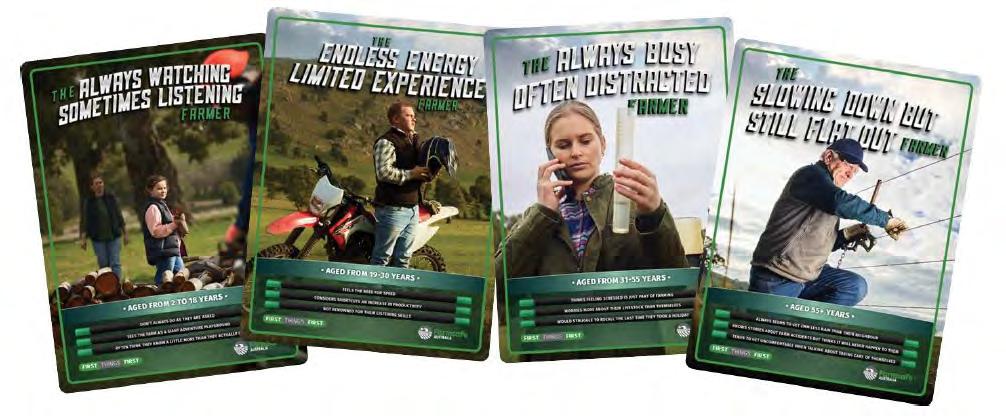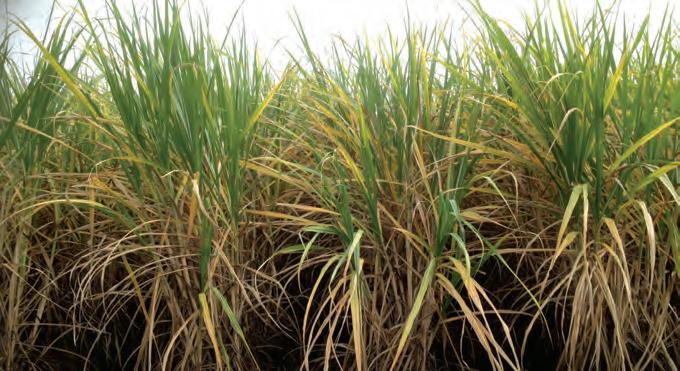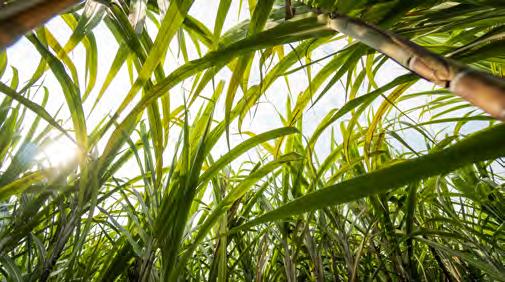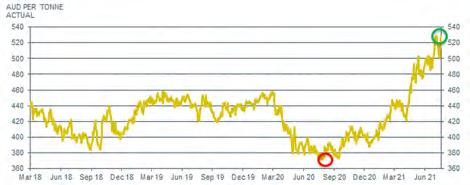
15 minute read
ON THE LAND
Talkin’ about your generation: Farmsafe Australia takes an intergenerational stance for farm safety
Farmsafe
Advertisement
IN 2020, agriculture was again ranked as the second most dangerous industry to work in by rate of fatalities1, with those over the age of 50 most at risk from farmrelated injuries or fatalities2. Farmsafe Australia is looking to tackle distressing trends and is pleading with communities to take greater responsibility in promoting safety issues in all rural areas, ahead of Farm Safety Week. This year, Farmsafe Australia wishes to celebrate how farms offer one of the most unique lifestyle experiences for all ages. Australian farmers are incredibly fortunate that they can live and work in the same place, and Farmsafe Australia wants to ensure all farmers have access to information that keeps them and their families safe and healthy from when they first pick up an egg at the age of two, right through to stepping off a tractor at the age of 92. Themed ‘Farm Safety Through The Ages - From 2-92’, this year’s campaign will highlight the key safety issues and risks that are most prevalent throughout the different life stages of a farmer, in the hope it will reduce the risk of injury, illness and fatalities so commonly associated with agriculture. Charles Armstrong, Chair of Farmsafe Australia says this campaign is not about restricting families who live and work on farms, far from it. It’s about embracing everything a life lived on the farm can offer, while minimising the risk of injury.
“We are focused on making safer farms an intergenerational topic of conversation in every rural community. The number of farm related fatalities in this country has not shifted dramatically in a decade3, so there has never been a more important time to discuss how we can make Australian farms a safer place to live and work,” said Mr Armstrong.
“By improving the availability of information on hazards, risk factors and practical safety solutions, we want to ensure all communication between agricultural representatives, farmers, government and other stakeholders is active, consistent and productive. It has never been more essential to develop a ‘safety culture’, while alleviating the pressures of farming life, across all generations within rural communities.
Farmsafe Australia is a national not-for-profit entity, advocating for farmers. It aims to connect state farming organisations, peak commodity bodies, influential advocacy bodies and other groups that share a common interest in agricultural health and safety. Its initiatives are based upon the philosophy that the primary responsibility for farm safety rests with individual farmers, farm workers, and their families.
CONNECT NOW:
For more information on farm safe practices visit www. farmsafe.org.au.
1 Safe Work Australia Fatality
Statistics, July 2021 2 Safer Farms 2020 Agricultural
Injury and Fatality Trend Report,
December 2020 3 Safer Farms 2020 Agricultural
Injury and Fatality Trend Report,
December 2020
Weekly production figures
Burdekin region mills Week 6, ending 17 July 2021
Cane crushed This week Season to date Invicta 147,701 833,497 Pioneer 81,875 436,426
Kalamia
77,829 410,693 Inkerman 56,475 335,987
Burdekin 363,879 2,016,603
CCS
Invicta Pioneer 14.48 14.38 13.80 13.82
Kalamia 14.09
13.46 Inkerman 13.86 13.27
Burdekin 14.28 13.65
Weekly variety performance for region
Variety % CCS Variety % CCS
Q240 42 14.33 Q183 10 14.68
KQ228 29 14.18 Q208 7 14.07
Q232 10 14.04
Comments:
Throughput for the Burdekin mills in week six was good overall, with more than 360,000 tonnes put through the rollers.
This brings the season-to-date total to just over 2M tonnes – or 25 per cent – of the estimated Burdekin crop.
The weekly result was above budget, despite Inkerman Mill’s extended stop to repair leaking boiler tubes and Invicta Mill’s stop to carry out repairs to the bagasse system.
Average weekly CCS was 14.28. This was again well above budget thanks to the dry cool conditions.
The highest CCS sample was 17.2 from a rake of Q240 plant cane in the Inkerman Mill area.
John Tait Cane Supply Manager Burdekin Region
Project wraps up but YCS mysteries remain
CANEGROWERS Chairman Paul Schembri
INDUSTRY scientists and growers have worked on the mystery of Yellow Canopy Syndrome (YCS) since it first appeared in 2012 but despite all the effort, major questions remain and more work is needed.
YCS has spread to most of Queensland’s sugarcane districts and sometimes the symptoms are so severe, it has a big impact on a growers’ cane yield and therefore income.
Recently, a major project costing around $10 million dollars was wrapped up by Sugar Research Australia.
With the cooperation of growers across many regions, more than 30 scientists and support staff approached the problem from a variety of angles and we thank them for their efforts.
Their final report, available on the SRA website and summarised in the July Australian Canegrower magazine, reports that no disease, vector, genetic or nutrient link was found to cause what has been described as induced leaf aging.
We do know that YCS interrupts the movement of sucrose from the leaves to the stalk – but the research has not been able to pinpoint why it happens or how to stop it.
The key, though, is plant stress. Basically, YCS will kick a crop when it is already down, and it will usually happen during the peak growing period between December and March.
Once affected, the yellow leaves don’t recover. In the worst cases the stalks become rubbery.
That tallies with what growers have seen. YCS will rear its head when there’s been rain after an extended dry spell.
On my farm I have seen too that there is no rhyme or reason as to why one block or area is heavily impacted and another one nearby, just across a headland, is not.
From the SRA research project, the best advice to combatting YCS at the moment is to reduce stress on the sugarcane plants.
As growers, we are always trying to reduce stress on our crop because when it is healthy, it grows.
So, I understand growers may feel disappointed by the outcome of the research project. We all like answers and a quick fix. This time, unfortunately, they are not available.
I’m not losing heart. Science constantly develops, new people come up with new ideas and new options can be tried.
It took researchers more than 80 years to identify the cause of chlorotic streak disease, which first appeared in 1929 and is one of the most common diseases in the Australian sugarcane industry. Only in recent times was the DNA of a water-borne organism that spreads it identified.
For this reason, research into YCS must continue beyond the end of this project.
SRA says it will continue to invest in YCS and this is critical.
We need a form of active, ongoing monitoring and a plan be ready to ramp up research again should anything change.
As with chlorotic streak, just because the cause can’t be found now, doesn’t mean that it won’t be discoverable in the future or that the current level of YCS across the industry won’t change.
So, it is important that growers stay vigilant and on the lookout for YCS symptoms.
In the meantime we are left with our questions: What causes Yellow Canopy Syndrome? How do we stop it? And the hope that the future holds the key.



On the Land is proudly supported by


CRUSHED: QUEENSLAND SUGAR INDUSTRY’S $1B HIT FROM INDIAN SUBSIDIES REVEALED
Wilmar Sugar
NEW analysis has calculated a $1 billion cost to the Queensland sugar industry from Indian Government price and export subsidies currently under investigation by the World Trade Organisation (WTO).
The finding has alarmed but not surprised peak industry organisations the Australian Sugar Milling Council (ASMC) and CANEGROWERS, who say it confirms the need for continued pressure from the Australian Government and industry against India’s subsidies.
The Green Pool Commodity Specialists report, commissioned by ASMC, found Indian Government sugarcane price regulation was causing large production surpluses and India’s subsidised exports had contributed to substantially lower global sugar prices. The report concludes that Queensland cane growers and sugar millers had incurred an estimated $1 billion revenue hit between 2017/18 and 2020/21 – or almost $5 million every week.
ASMC Director, Policy, Economics and Trade David Rynne said Australia, Brazil and Guatemala made a formal complaint to the WTO in February 2019 regarding the harm caused by the Indian Government subsidies to their sugar industries. The WTO panel’s report on the complaint may be handed down during 2021.
“Over the past four years, these subsidies have hurt Queensland growers, millers and sugar industry employees, their families and communities. ASMC is commissioning further analysis to determine the wider impact on the regions and the State’s economy,” Mr Rynne said.
“The Green Pool report concluded that India’s current sugar production of more than 33 million tonnes exceeded its domestic sugar consumption of about 26 million tonnes. This excess subsidised production means export subsidies are likely to be an ongoing feature for many years if it is not reined in,” he said.
ASMC and CANEGROWERS have praised the Australian Government for its advocacy on behalf of the sugar industry to date and urged continued support for growers, millers, dependent businesses and regional communities which continue to feel the impact of price distortions in the global sugar market.
CANEGROWERS Chairman Paul Schembri said the Australian Government had strongly backed the industry through the WTO case, but with concerning reports the Indian Government may be considering another package of export subsidies, it is clear that maintaining the collective effort of our diplomatic representatives to the Indian Government will be crucial.
“We are hopeful the WTO will find against the Indian subsidies because the economic pain for Australian growers, millers and sugar communities could be profound and prolonged if they continue,” Mr Schembri said.
“We will be sharing the findings of this report with the Australian and Queensland governments, and our local parliamentary representatives,” Mr Schembri said, “We want to work with them to ensure progress on the path to a fairer global market for sugar.”
ASMC estimates of the regional breakdown of industry-wide impacts highlighted in the Green Pool report:
The impacts have been across the sugar regions over the last four seasons are: • $212.5 million in the
Northern region including the mills of Tableland,
Tully, South Johnstone and
Mossman; • $151.2 million in the
Hinchinbrook region including the mills of
Victoria and Macknade; • $306.8 million damage over four years in the Burdekin region including the mills of
Pioneer, Inkerman, Kalamia and Invicta; • $276.9 million in the
Mackay and Whitsunday region including the mills of Farleigh, Marian,
Racecourse, Plane Creek and Proserpine; and • $106.6 million in the
Bundaberg and Wide Bay region including the mills of Isis and Millaquin and the now closed mills of
Bingera and Maryborough, which completed their final crushes last season.
The Green Pool report found:
“India’s sugar export subsidy programme since 2017/18 has become virtually institutionalised. India is now a structural exporter of sugar, with subsidies on exported sugar of up to one-third of an Indian mill’s cost of production of raw sugar.”
“Besides export subsidies and regulated cane prices, India’s government also fixes domestic sugar prices well above global prices and provides soft loans to milling companies to build ethanol distilling operations to utilise sugar and processing byproducts.”
“The decision of India’s government to financially support significant levels of exports (initially compulsory) has had a real and perverse impact on the global market.”

Has the Government cried Reef one too many times?
AgForce Reef Taskforce Chair Alex Stubbs
WE’VE all heard of the boy who cried wolf. But what about the Minister who cried Reef?
For years now the State Government has told all who will listen that agricultural runoff is destroying the Great Barrier Reef - despite the fact that the science behind this call is outdated and false.
Over and over the Department of Environment and Science has attacked our farming community, spouting propaganda from green groups and a handful of cherry-picked scientists.
All the while AgForce and industry have been forced to defend themselves, while fighting a raft of new Reef regulations crippling livelihoods.
To her credit, Environment and Great Barrier Reef Minister Meaghan Scanlon navigated through some very sensible amendments to the expanded cropping regulations at the start of her term, but there is still a long way to go.
And now the ‘wolf’ has arrived.
The United Nations Educational, Scientific and Cultural Organisation (UNESCO) and World Heritage Committee (WHC) are heeding Government claims about threats to the Reef and considering an ‘in danger’ listing.
It’s prompted Federal Environment Minister Sussan Ley to present UNESCO ambassadors with new, validated Reef facts – observations by expert, unbiased marine scientists, which indicate the Reef is in good health and recovering from previous weather conditions.
Five years of applied Reef science from the National Environmental Science Program Tropical Water Quality Hub (NESP-TWQ) also indicates the 2017 Reef Scientific Consensus Statement is outdated - rising ocean temperatures are the biggest threat to the Reef, not fertiliser, pesticide or sediment runoff from agriculture.
The game has changed.
As the old fable goes, when the shepherd boy really did see a wolf coming for his flock, he called for help but nobody came.
So will the same ring true in this instance?
AgForce has long since questioned whether the Reef is really in danger or if there are other motivations behind the Government’s cries.
This new chapter in the story of The Minister who Cried Reef gives us a moment to pause, check the quality of Reef science one more time, and again lobby for a national Office of Science Quality Assurance (OSQA) to check the validity of the science underpinning government policy.
Then and only then will we be able to believe the Government is telling us the truth next time the Minister cries Reef.
QSL Market Update
current as of 20 July 2021
Raw Sugar prices
• The Oct21 ICE 11 raw sugar contract bounced off a low of 16.73 USc/lb last Tuesday before trading up over 100 points to a high of 17.78 USc/lb on Friday, closing last week up 2.5%. • Brazilian crop progress for the second half of June was released by UNICA (the Brazilian Sugarcane Industry
Association) last Monday, with cane crush figures coming in above expectations due to quality production weeks in the Sao Paulo state. Cane harvested this season to date was reported to be 210.9 million tonnes compared to 230.4 million tonnes at the same time last year, with sugar produced at 12.3 million tonnes compared to 13.3 million tonnes in 2020. Despite Brazil’s cane and sugar production lagging last season by approximately 8%, the area harvested is actually 2.5% ahead, implying their crushing season will likely end relatively early. • More cool weather is predicted for Brazil, spooking the market with fears of another frost that could damage the crop further. Longer term, the US Climate Prediction Center has reported that a La Nina pattern may appear again later this year, potentially bringing another year of poor rainfall for the Southern Brazil cane areas. • The Indian Sugar Millers Association released its first estimate of the 2021/22 Season Indian crop at a forecast 31 million tonnes of sugar. This is virtually the same as their 2020/21 Season production but still lower than the market consensus. • Just as ICE 11 sugar prices have been range bound for the past two months, the net speculator position has followed a very similar pattern, trapped in a 185,000 – 250,000 lot net-long position. The latest Commitment of Traders report dated 13 July reported specs reduced their position to 194,000 lots net long.
2021-SEASON RAW SUGAR PRICES

This is a whole-of-season ICE 11 price chart for the 2021 Season, based on the current 3:2:1 pricing ratio applicable to QSL Target Price Contract growers. Source: Bloomberg
Currency
• Markets continued to trade in a risk-off tone last week as the US Dollar strengthened and the Aussie Dollar (AUD) underperformed after the extended Sydney lockdown was expanded to Melbourne. The AUD slipped from its high of 75.83 US cents last Tuesday down to a low on Friday of 73.92
US cents. • For the third month in a row, the US consumer price index (CPI) was much higher than expected, printing at 0.9% month on month – more than double the market consensus.
Almost half of this figure can be attributed to a 10.5% month-on-month increase in used car prices which are now statistically 45% higher than at this point last year. Despite the US Fed continuously reassuring that this inflation is only transitory and is expected, markets remain fearful that it could be more enduring and lead to an earlier interest rate hike. • Domestically, the unemployment rate has fallen to levels not seen since December 2010, dropping from 5.1% to 4.9%.
Despite the positive surprise, the numbers were hardly market-moving, as investors remain focused internationally.
To read our full commentary in the QSL Market Update, please visit www.qsl.com.au or contact the Burdekin QSL team: Russell Campbell, Grower Relationship Manager 0408 248 385 Kristen Paterson, Grower Relationship Officer 0438 470 235 Rebecca Love, Grower Relationship Officer 0429 054 330
This report contains information of a general or summary nature. While all care is taken in the preparation of this report, the reliability, accuracy or completeness of the information provided in the document is not guaranteed. The update on marketing and pricing activity does not constitute financial, investment advice. You should seek your own financial advice. Nothing contained in this report should be relied upon as a representation as to future matters. Information about past performance is not an indication of future performance. QSL does not accept any responsibility to any person for the decisions and actions taken by that person with respect to any of the information contained in this report..






